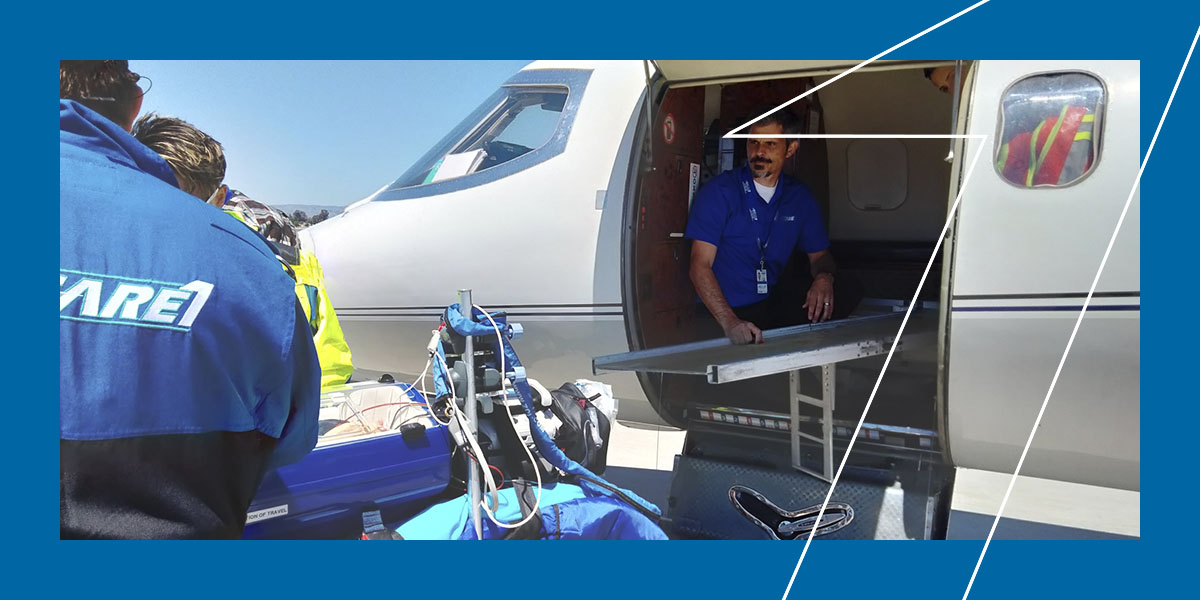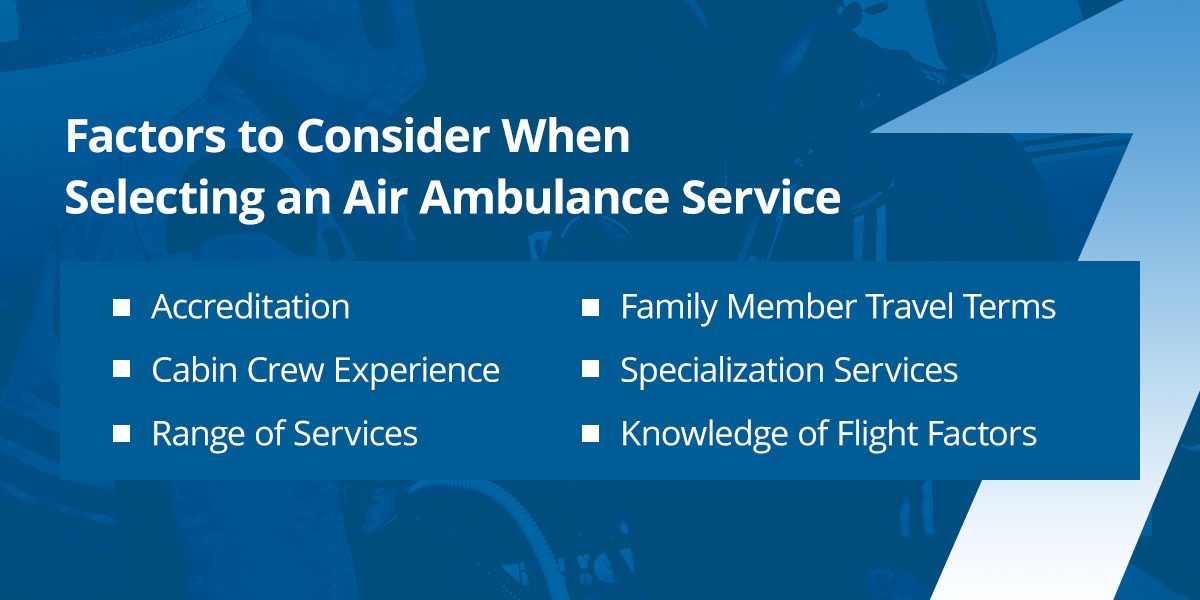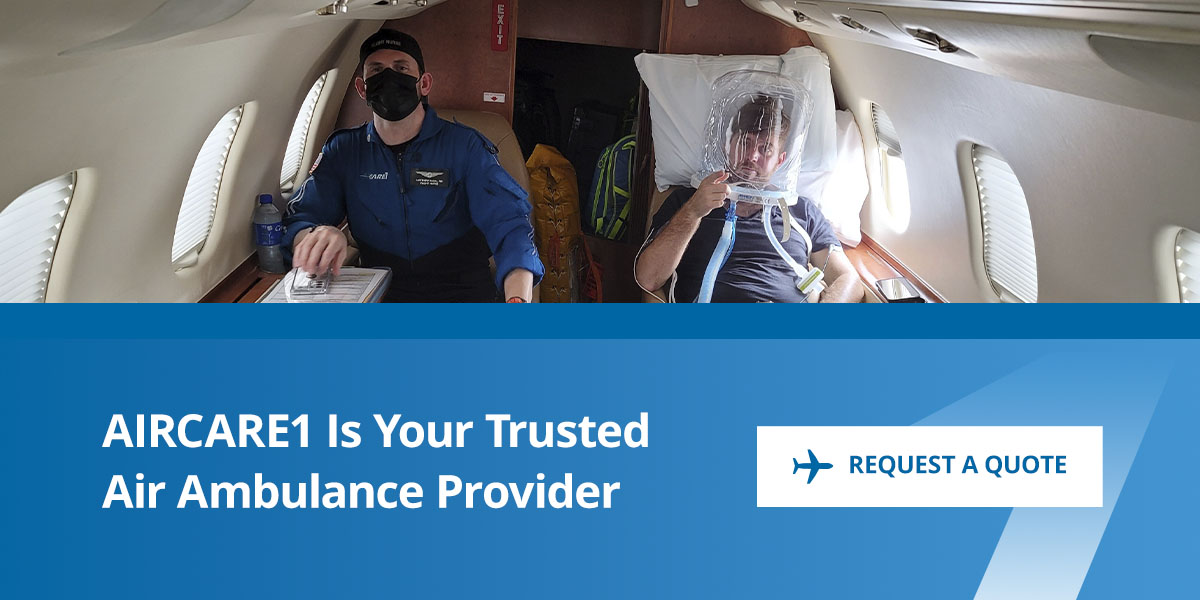As a case manager for a patient that is in need of an air ambulance service, you play a significant role in ensuring your patient receives seamless medical transportation and facilitating the process between hospital and air care. While this responsibility is delicate, you can successfully support your patients through their medical journey with the proper preparation.
What Is an Air Ambulance?
An air ambulance is an aircraft that transports patients from one location to another in medical situations. These aircraft have the necessary equipment and a trained cabin crew for treating patients during emergency and non-emergency travel. There are two standard types of air ambulances:
- Rotor wing aircraft: These are helicopters that can take off and land on airport landings. They often have less equipment and are used for shorter, intercity, emergency transports.
- Fixed-wing aircraft: Jets or airplanes are typically used for longer, state-to-state, flights. These aircraft often carry more equipment than helicopters and require an airport strip for landing and takeoff.
When Would a Patient Need Air Ambulance Services?
While the reasons for calling an air ambulance can differ, there are common instances in which patients might need medical air transportation services:
- They require transportation from a remote or rural location to a hospital for treatment.
- They’re going from one hospital to another for specialized care.
- They need to get to a hospital near home from a vacation spot.
- They need to travel from their hospital room to an ICU center quickly.
- They need transportation from a rural medical facility to a specialized care facility in another city.
Why Is an Air Ambulance Important for Medical Transport?
An air ambulance provides comprehensive patient care and rapid, comfortable, safe transportation in various medical situations. Whether patients require ICU-level care or 24-hour supervision, air ambulances facilitate these needs during the long-distance air ambulance flight. Here are some more benefits of air ambulance services.
Constant Care
Air ambulances provide bedside to bedside service for patients being transported. Skilled and well trained nurses and paramedics medically care for patients through the entirety of the flight by monitoring ventilation, administering medicine, and tracking conditions and symptoms.
Access to Remote Regions
Patients in remote or rural areas might need access or transportation to hospitals in adjacent or faraway cities/states. Air ambulances can transport patients to hospitals and specialized medical units from remote locations. These flights can be long, and during them, staff can provide patients with knowledgeable and valuable care until they reach their destination.
Medical Tourism
Traveling commercially can be challenging for people with health conditions like cancer or patients recovering from surgery. These patients require medical assistance and comfortable travel accommodations. Air ambulances provide non-emergency travel services with appropriate medical attention, suitable equipment and a relaxed environment, ensuring patients have an enjoyable travel experience. As a cost-effective alternative, these kinds of patients can also benefit from commercial medical escorts who can medically care for them on commercial flights.
Critical Care Services
Burn victims, cancer patients and life support patients may require specialized and intensive care at locations far away from where they live. Transporting patients with these conditions is a delicate process and requires the utmost respect. Air ambulances are spacious and equipped to carefully treat severe conditions and provide patients with the comfort and support they need until they reach their destination.
Comprehensive Support
Air ambulance staff understand various flight factors like different air pressures and heights. They know how to provide accurate care amid these conditions, ensuring patients get adequate and safe treatment. For example, for patients with spinal injuries, pain can worsen during travel. The onboard medical staff knows how to manage this pain and transport patients comfortably.
Rapid Transportation
Transporting patients to a faraway location can be a time-sensitive task. Navigating different terrains and weather can delay travel. Air ambulances are equipped to travel swiftly through numerous conditions.
Factors to Consider When Selecting an Air Ambulance Service
When booking an air ambulance, you must evaluate the following factors
Accreditation
Air ambulances traveling internationally require certification and licensing from governing authorities. Look for certificates from accredited and renowned boards like the Commission on Accreditation of Medical Transport Systems (CAMTS) and the European Aero-Medical Institute (EURAMI). These documents signify that an air ambulance has been vetted and meets the safety, professional and quality standards and requirements to operate as a medical air ambulance.
Cabin Crew Experience
Credible air ambulance companies have experienced and trained medical teams, technical staff and ground staff. Check the company website and call the customer support team to confirm the staff has appropriate licensing and certifications.
Range of Services
Ensure the air ambulance company can provide non-emergency and emergency services. Additionally, confirm if they can provide services like checkups, round-the-clock care, bed-to-bed transportation, aromatherapy and pre-flight evaluation. They should also have a 24/7 customer call center.
Family Member Travel Terms
Some airlines have particular terms, such as additional costs for family members traveling onboard. Check if an air ambulance service offers family member travel and the associated guidelines. If they allow family travel arrangements, ensure you know what documents they require and if additional fees are needed.
Specialization Services
If a patient requires specialized medical services, like palliative care, intensive care, ophthalmology and pediatrics, checking if an air ambulance has experts in these fields is essential. Call the customer services dispatch and ask about the medical staff’s capabilities, qualifications and experience in various specializations.
Knowledge of Flight Factors
Factors like acceleration pressure, G-force, weather, vibrations and gravity can impact a medical flight and its patients. Experienced onboard medical teams will have training in dealing with and treating patients amid these conditions. They will know how to stabilize patients during turbulent weather and prevent side effects like nausea and hypertension.
Medical teams will also know what protocols to take in emergencies and have the skills to make rapid decisions. Confirm that air ambulance staff members have the appropriate aviation and medicine training to support and care for patients.
What Is the Role of a Case Manager in Air Ambulance Coordination?
As a case manager, you’ll undertake many duties and responsibilities when coordinating an air ambulance for patients, including:
- Information coordination: Source vital documentation like patient medical records and fact sheets. Have them ready to hand to the air ambulance team on arrival.
- Logistics management: Understand the situation and whether it’s an emergency or non-emergency. You can communicate with ambulance teams to ensure you use the suitable mode of air transport for your patient.
- Staff oversight: Communicate the patient’s needs to air ambulance staff and ensure they have the skills and expertise to treat and support their condition.
What to Expect During the Air Ambulance Booking Process
While the booking process can differ between air ambulances, here are some common steps you can expect when scheduling an air ambulance for a patient:
1. Get a Quote
When you contact or request a quote from an air ambulance, they will first ensure your patient meets the specifications for air transportation and that they have a receiving facility to be transported to. These requirements can include if the patient is emergent or non-emergent, confirming the type or aircraft to be used, and patient insurance.
2. Collect Patient Information
If you meet the specifications, the team confirms your patient’s sending and receiving location to ensure they are in their service area. They will also ask you for information like the patient’s medical conditions, history and fact sheets. The air ambulance team will establish if your patient is fit for flight and confirm staff and equipment requirements.
3. Verify Payment Information
Before the quote is accepted, you as the case manager will need to coordinate with the patient’s insurance company to get authorization for the transport. If insurance does not authorize the flight, the patient may need to pay for the transport out of pocket. Payment is verified once the flight is cleared for travel and received before the flight takes place. No additional payments should take place after the flight is completed.
4. Prepare Your Patient
On the day of transportation, you will prep your patient for their transfer and flight. The air ambulance will provide a checklist to ensure your patient is ready for flight. This list can include points like:
- Gathering Patient Information
- Medical Necessity Form
- Air Ambulance Transport Form
- Copy of Insurance Card
- Confirming medical conditions, equipment and staffing needs.
- Essential travel information for family members.
5. Enjoy Seamless Medical Transfer
The air ambulance will arrive at the arranged time for a seamless and safe transfer. The medical air transportation team will transfer your patient safely and securely from the hospital to the bed on board, where they will receive medical care and support until they land. They will arrange transportation to and from the patient’s receiving medical facility. Air ambulance teams will update the family on travel timelines and patient conditions. They will also inform you when the patient arrives safely and is checked into their facility.
AIRCARE1 Is Your Trusted Air Ambulance Provider
An experienced flight crew is essential for a safe and supportive air ambulance experience. AirCARE1 offers more than medical air transportation. Our values, including professional, experienced and holistic care services, help our patients feel comfortable and at ease during travel. Our medical crews have the training and skills to carefully support patients in multiple flight circumstances and provide them with a safe and comfortable journey.
Contact us to get an upfront quote!
Linked Sources:
- https://www.airambulanceone.com/what-is-the-advantage-of-air-medical-transports/
- https://www.airambulanceone.com/5-common-uses-air-ambulance/
- https://www.camts.org/about/
- https://eurami.org/accreditation/
- https://www.airambulanceone.com/top-end-of-life-care-facilities-in-the-united-states/
- https://www.jems.com/patient-care/critical-considerations-for-fixed-wing-air-medical-transports/
- https://www.airambulanceone.com/should-get-medical-evacuation-insurance/
- https://www.airambulanceone.com/request-a-quote/




